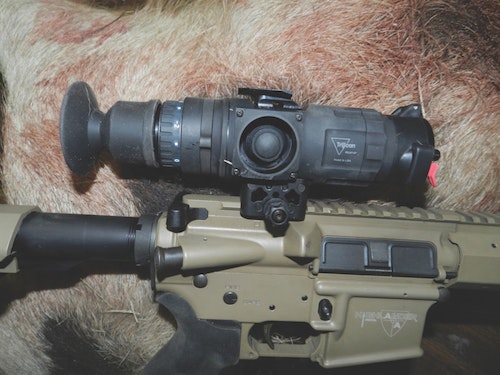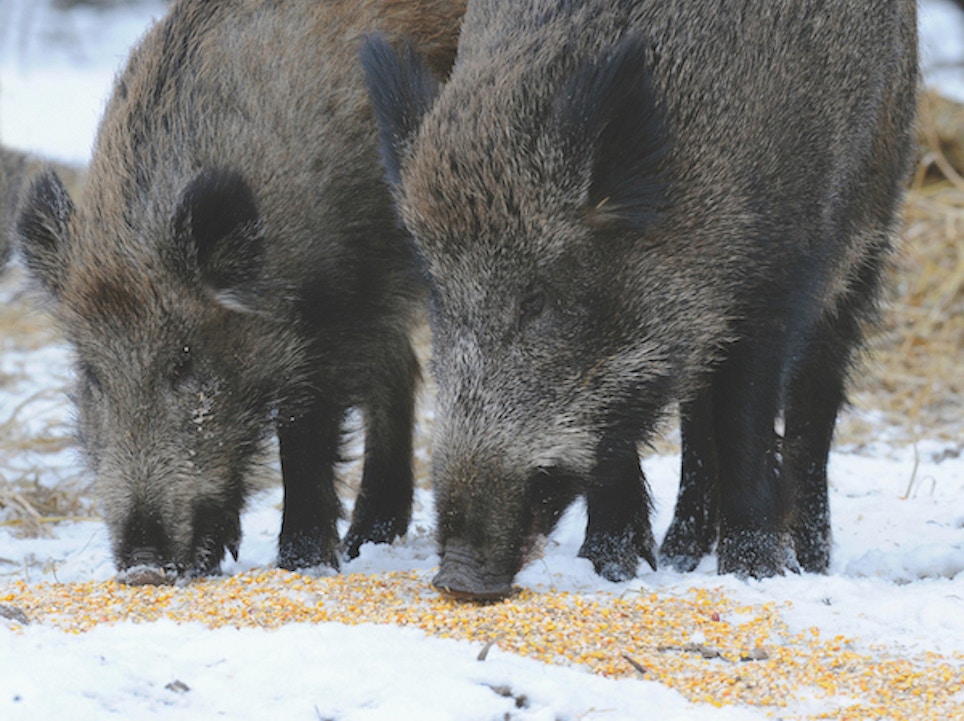It seems that wild hogs are perpetually and incurably hungry. So, while they are remarkably intelligent animals overall, they often make unintelligent decisions when there is free food involved. For instance, returning to a feeder site where one of their buddies just got it there the past week — because … Free Corn! I would venture to say far fewer hogs would be killed by hunters without the use of bait, most commonly dispensed via a timed feeder and guarded by a strategically positioned stand or blind.
This mode of operation is certainly effective, typically offering predictable results in better hog habitats. So maybe that’s why it lacks a bit of excitement for me. I have certainly engaged in such hunts. After driving 30 hours south from Idaho to bowhunt with Texan friends each December, sitting over a feeder being pounded by hogs immediately after arrival is a great way to kick off the festivities, get the skunk off a hunt and settle the nerves. My amigo Steven Tisdale seems always to have such a place waiting for me. But it’s not something I’d want a steady diet of, because it lacks a certain degree of adventurous sport.
For that we go stalking. And to assure steady spot-and-stalk action, bait remains a key component of the equation. In this case bait involves my long-time hunting partner, Tisdale, driving his pickup along ranch roads with me sitting on the tailgate trickling a thin trail of whole corn. During the dark of morning, under freezing temperatures, we might both have a bag of corn sitting in our laps, tossing handfuls of the yellow candy out the windows. When we reach known hog crossings or thicker draws, we dispense extra feed to better get things going. Tisdale and I have labeled this “circuit baiting.”

Making the Circuit
Morning circuits, arriving an hour early to lay down bait trails under the cover of darkness, are used to provide daytime spot-and-stalk opportunities for later in the morning, usually after it has warmed a bit and hogs are moving better. Evening circuits are primed for after-hours thermal-imaging/AR-rifle hunts. The daytime excursions, after coming off a whitetail stand usually, are spot-and-stalk bowhunting affairs and huge fun. The nighttime forays become culling missions, pure and simple. Both provide plenty of opportunity to put lot of pork chops and sausage in the freezer, because in the immortal words of Vincent Vega (Pulp Fiction), “Pork chops taste good. Bacon tastes good.”
These circuits, for the most part, are far from random — the best created by driving a loop of ranch roads that can be easily covered from a truck, ATV or even an e-bike. This works best on larger ranches with room to roam, but I can see it working on smaller Deep South properties I have hunted in the past, following mowed fence lines or farm-field edges near swampy habitats. The ranches we hunt in West Texas, for instance, range from 15,000 to 38,000 acres, meaning we often lay down miles of dribbled corn. In other habitats, where a large patch of swamp, thick vegetation, or in the case of one Texas property we hunt, a 200-acre overgrown playa lake, we might trickle bait along a single length of road upwind of the hog sanctuary. It is simply amazing how hogs can detect the aroma of dry corn from hundreds of yards away, especially when the wind is in their favor. Though, given enough time, they seem to find bait trails no matter the wind direction.
Choosing your battlefield also helps your cause, making bowhunting efforts more productive. In West Texas, Tisdale and I concentrate on the rolling, broken topography spilling off the higher caprock. In South Texas we operate in the thickest vegetation we can find. In the Deep South I’d look to creek beds, cane breaks and briar patches that appeal to wild hogs. Locked Texas properties with daily oil field, wind turbine or general ranch activity also seem to be most productive, as hogs become accustomed to truck traffic and aren’t as inclined to scattering wildly at the approach of a vehicle.
Rougher topography with humps, ridge points and twisting roads, or thickly vegetated terrain, really works to the hunter’s advantage because it provides more cover for the vehicle you travel in. During daytime hunts we are careful to creep around sharp corners or crests in the road so we can watch ahead for hogs occupied with feeding, or even places that allow glassing ahead at even longer distances. In many instances we park around road bends or behind rises and stalk ahead to have a quick look, especially along proven stretches or places showing copious sign such as rooting or tracks. During nighttime hunts topography or thick brush acts as a veil to vehicle headlights and crunching tires.
Double the Pleasure
What I really like about this approach to hunting hogs is it doesn’t take away from other activities. When it comes to Texas feeders, for instance, there are those taken over completely by hogs — that actively ward off deer in their greed — and deer spots penned to keep hogs away and ensure deer feel secure. You generally have a choice — a hog or deer hunt — when guarding feeders. Circuit baiting allows enjoying a morning or evening sit for whitetails while the bait trail you have laid earlier works its magic. If nighttime hogs are your only concern, circuit baiting also allows laying down a bait trail and catching a quick nap before the all-night festivities begin.
Nighttime hunts are a little different because vision is obviously restricted. There is much less parking and walking, with nearly all operations based from the truck. One West Texas ranch we hunt frequently is festooned with power-generating wind turbines that require constant maintenance. This means hogs have become accustomed to regular truck traffic. On that ranch we run with the headlights on. Another ranch sees infrequent traffic, making hogs a bit more wary. On that place Tisdale kicks off the headlights (pushing the emergency brake in one click allows this, my own truck not allowing running without headlights) and navigates with my night-vision goggles.
On warm nights I’ll stand in the bed, scanning ahead with a thermal binocular or the weapon unit itself, tapping on the roof when “hotspots” are detected ahead. On cooler nights I hang out the passenger window with the heater running, resting the thermal-equipped rifle on the rearview mirror. I dismount when hogs or hotspots requiring closer inspection are discovered.
You can certainly get away with much more when closing the gap on hogs feeding in the dark. Overall, they seem more at ease and secure after nightfall. A little bit of crunching gravel or snapping twigs doesn’t seem to concern them at night like it would under full sunshine. They simply seem to become blind at night. Wind, of course, is still very much a factor, because it is what hogs live by — even when hunters are approaching in a vehicle. I move forward slowly, keeping the wind in my face, checking progress through the thermal occasionally. A rifle obviously provides greater reach, but a real problem with thermal technology — especially more affordable thermal-imaging units — is they often fail to reveal cooler brush or clumps of grass that easily deflect speeding bullets. Even when shooting an AR capable of quick kills out to 300 yards, I move as close as possible to ensure clean shots.

Rifles of Choice
Any rifle type will work in this business. I once attached a compact Sig Sauer ECHO1 thermal reflex sight on a Thompson/Center Contender pistol chambered in .30-30 Win., just for fun. Another time I mounted a high-tech thermal unit to the Picatinny rail of a Marlin Model 336 Dark Series .30-30 Win. to see what that was all about. Yet, I still prefer an AR-15 chambered in something such as the .224 Valkyrie loaded with 90-grain Fusion bullets, the 6mm ARC with 103-grain Hornady ELD-X bullets, or especially the 6.5 Grendel or 6.8 Rem. SPC loaded with 123- or 120-grain Hornady SST slugs.
The AR-15 preference is simple: Nighttime hunting is usually culling work, Tisdale viewing hogs as direct competition for the trophy whitetail bucks he’s so passionate about. ARs are better equipped to hold useful nighttime gear, and when I walk into a nighttime herd my goal is to lay down as many hogs as possible before they scatter into cover. An AR offers faster follow-up shots via its semi-auto action, but also less recoil. With a suppressor installed and some lucky breaks, I’ve laid down five to six hogs in a single approach — some of these running toward me after the first shot was fired! Adding 10 inches of suppressor to a 16-inch barrel becomes a hassle when getting in and out of a vehicle but is well worth it for the additional shots it provides on a sounder of hogs.
My current hog-dedicated AR-15 is a parts-build 6.8 Rem. SPC with a 16-inch threaded barrel. The SPC edges out the Grendel slightly at close range; 6.5mm bullets running away from it at longer ranges due to superior ballistic coefficients. In any case, while putting the SPC together I chose a skeletonized forearm with Picatinny rails on four sides. This allows adding a weapons light, usually a compact Streamlight TLR-1 Game Spotter or a Cyclops VB250 Varmint Light added when wandering farther from the vehicle due to its farther reach. These powerful, on-demand lights include green or red filters, which makes them less visible to color-blind hogs, used to ensure I don’t trip over cactus during winter hunts, or step on a rattler during warmer spring/summer hunts while approaching hogs. Note: Hogs will react to shadows created even by filtered light, so avoid pointing it directly at them. A compact laser proves useful should you approach a spine-shot hog to discover it needs a coup de grace.
I’ll no doubt sit over a hog feeder again one day. I do love killing hogs, after all. Even after killing hundreds, from California (where baiting generally isn’t legal) to New Mexico, Mississippi to Florida, I can’t get enough. But for pure, unadulterated excitement, circuit baiting has become my preferred mode of operation in hog habitats.






